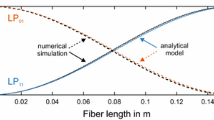Abstract
Resonant coupling of light beams via high-index media or gratings to planar waveguiding structures are of interest for both applications and from a theoretical point of view. Coupled Mode theory (CMT) can give an accurate description of the coupling process in terms of relatively simple expressions involving often a large number of coupling parameters. In this paper it is shown, using time reversal and energy conservation how these parameters are interrelated. The evaluation of the remaining independent parameters is shown to be possible using a few reflection and transmission coefficients for incoming plane waves, including in the calculations, if present, the effect of the grating. Further, it is proved that under certain condition a grating coupler may show exactly 100% reflection. Analytical expressions for the reflected and transmitted beams and the amplitude distribution of the excited mode are given for the case of incoming Gaussian beams. A few applications of the theory and considerations on its applicability are presented.
Similar content being viewed by others
References
Abramowitz, M. and I.A. Stegun (eds). Handbook of Mathematical Functions, Natl. Bur. Stds., Dover Publications Inc., New York, USA, 1970.
Avrutsky, I.A. and V.A. Sychugov. J. Modern Opt. 36 1527, 1989.
Bertoni, H.L., L.H.S. Cheo and T. Tamir. IEEE Trans. Antennas Propagat. 37 78, 1989.
Chandezon, J., M.T. Dupuis, G. Cornet and D. Maystre. J. Opt. Soc. Am. 72 839, 1982.
Ctyroky, J.C., S. Helfert and R. Pregla. Opt. Quant. Electron. 30 343, 1998.
Haus, H.A. Waves and fields in optoelectronics. Prentice-Hall Inc., Englewood Cliffs, New Jersey, 1982.
Hessel, A. and A.A. Oliner. Appl. Opt. 4 1275, 1965.
Hoekstra, H.J.W.M., J.C. van't Spijker and H.M.M. Klein Koerkamp. J. Opt. Soc. Am. A 10 2226, 1993.
Matlab, software tool distributed by The MathWorks, Inc.
Peng, S.T., T. Tamir and H.L. Bertoni. IEEE Trans. Microwave Theory Tech 23 123, 1975.
Rosenblatt, D., A. Sharon and A.A. Friesem. IEEE J. Quant. Electron. 33 2038, 1997.
Smith, R.E., S.N. Houde-Walter and G.W. Forbes. IEEE J. Quant. Electron. 28 1520, 1992.
Sychugov, V.A. and A.V. Tishchenko. Photon. Optoelectron. 1 79, 1993.
Syms, R.R.A. and J.R. Cozen. Optical guided waves and devices. McGraw-Hill Book Company, London, 1992.
Tamir, T. and S. Zhang. In Guided-Wave Optoelectronics, eds. T. Tamir et al. Plenum Press, New York, 1995.
Ulrich, R. J. Opt. Soc. Am. 60 1337, 1970.
Wood, R.W. Phil. Mag. 4 396, 1902.
Author information
Authors and Affiliations
Rights and permissions
About this article
Cite this article
Hoekstra, H.J. Coupled mode theory for resonant excitation of waveguiding structures. Optical and Quantum Electronics 32, 735–758 (2000). https://doi.org/10.1023/A:1007006226372
Issue Date:
DOI: https://doi.org/10.1023/A:1007006226372




